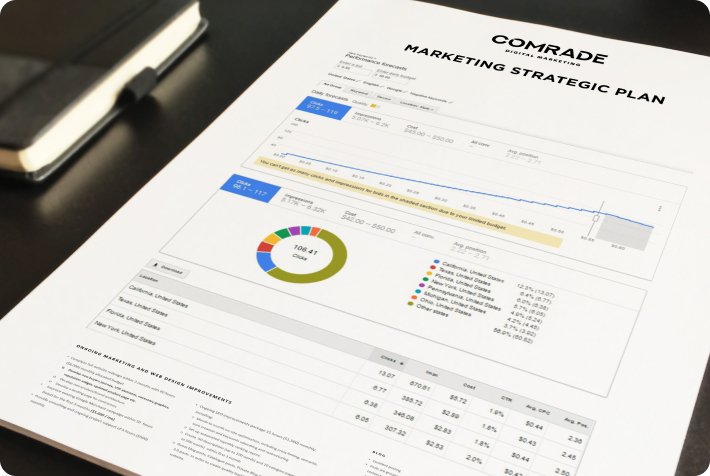Shoes are a life necessity, just like food and clothing; thus, they’ll always be in demand. Any retailer that has shifted focus to online commerce, would have had to invest a great deal in building a website that provides the best possible user experience.
While you can’t try on shoes at Zappos.com, the company’s comprehensive product descriptions, demo videos, and seamless return policies make shoppers feel like they’re right in their physical retail store—with the added convenience of eCommerce.
If you’re running a custom shoe eCommerce store, your website must be replete with quality user experience design (UX), comprehensive product descriptions and amazing images that showcase brilliant footwear styles.
A great eCommerce website design is both aesthetically pleasing and easy to use. When designing your shoes website, you need to consider:
- UI and UX design
- Graphic design
- SEO
- Loading speed
- Unique selling proposition
We’ll get into more technical details a bit later, but first, here’s a list of standout website designs in the shoe retail industry that encompasses all the attributes needed to generate shoes website traffic and online sales.
Great Web Design From the US and Beyond
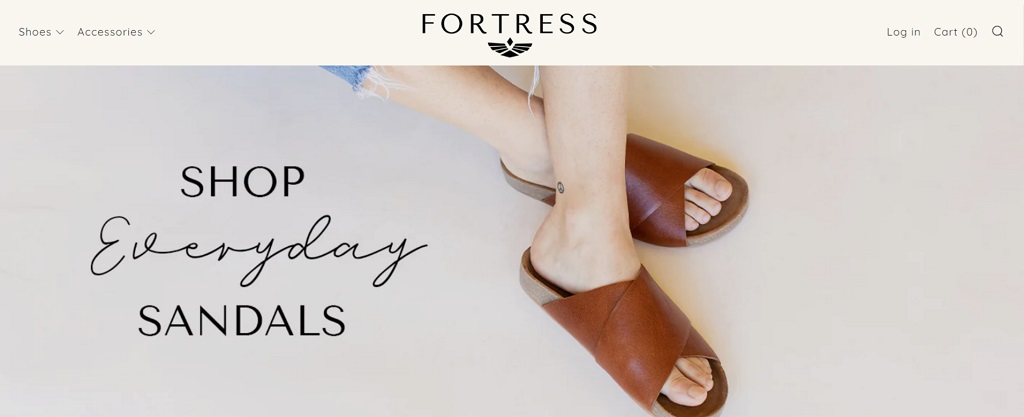
Fortress of Inca partners with some of the best shoemakers in the world to craft custom shoes using natural materials and adhering to responsible production practices. The functional website has a clean, simple design and a seamless check-out process. The company’s “Meet Our Shoemakers” section will undoubtedly instill a love of quality shoes and foster a loyal customer base for life.
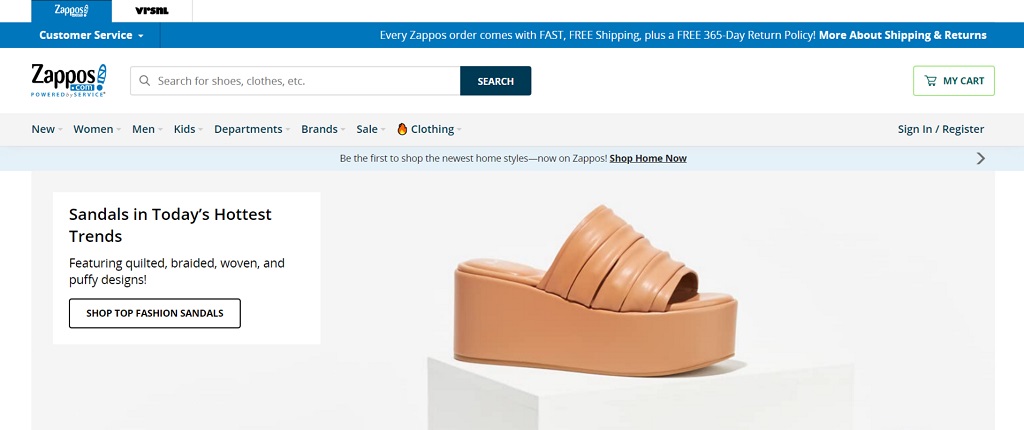
Zappos is the gold standard when it comes to building an eCommerce shoe store. It’s vivid, user-friendly, and comprehensive. What makes this website remarkable are its high functionality, customer-centric return policy, demo videos and detailed product descriptions. Its mega menu is also a good example of how to design robust navigation for shoe stores with large inventories.
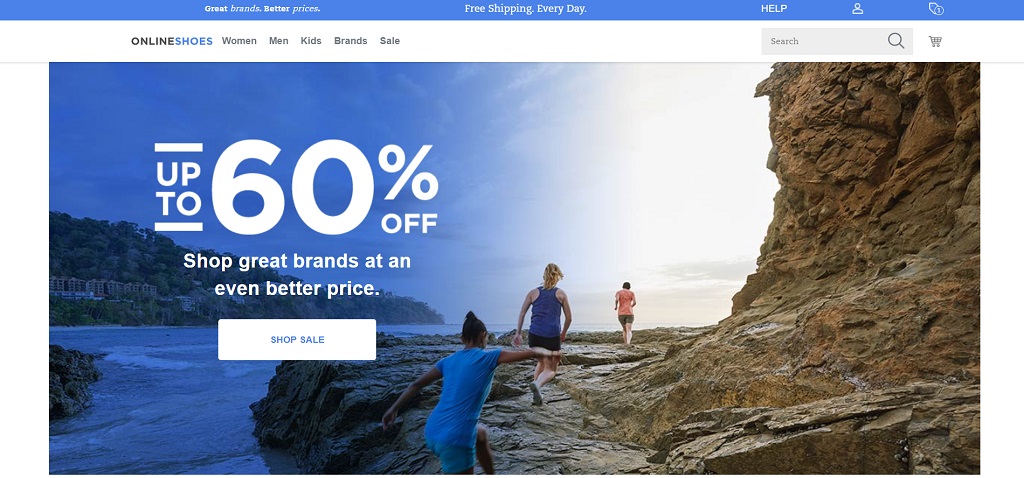
OnlineShoes offers a wide variety of quality shoes, apparel, and accessories. Its header design does an impressive job at grabbing shoppers’ attention and encouraging them to buy products.
The company simplifies its shoes eCommerce process with an intuitive website structure, while its well-designed filtering system lets buyers select shoes based not just on size, but also on activity level, functionality, design, and more.
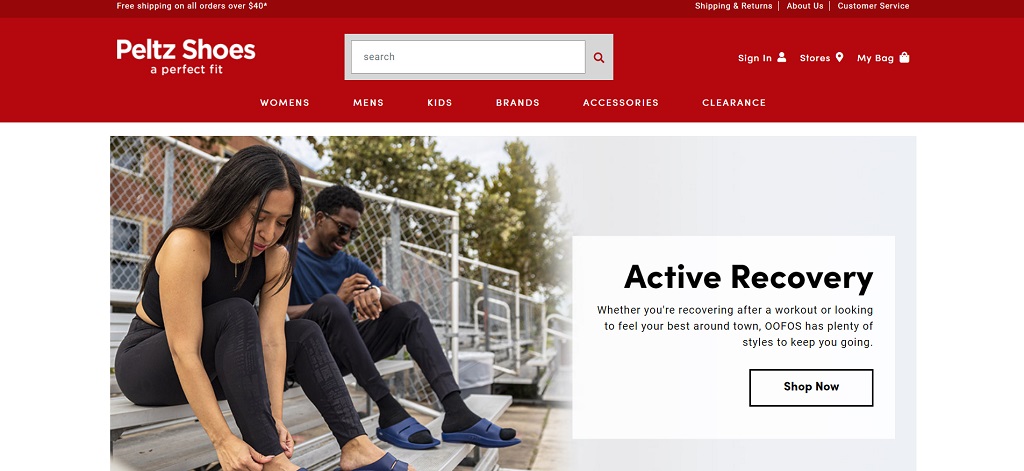
Peltz shoes offer name-brand shoes in hard-to-find sizes at great prices. Its customer-centric ethos translates through its neat website design, where a giant search bar makes it easy to find the exact shoes you’re looking for. It’s also possible to shop for shoes by size, which is a rare, yet useful device.
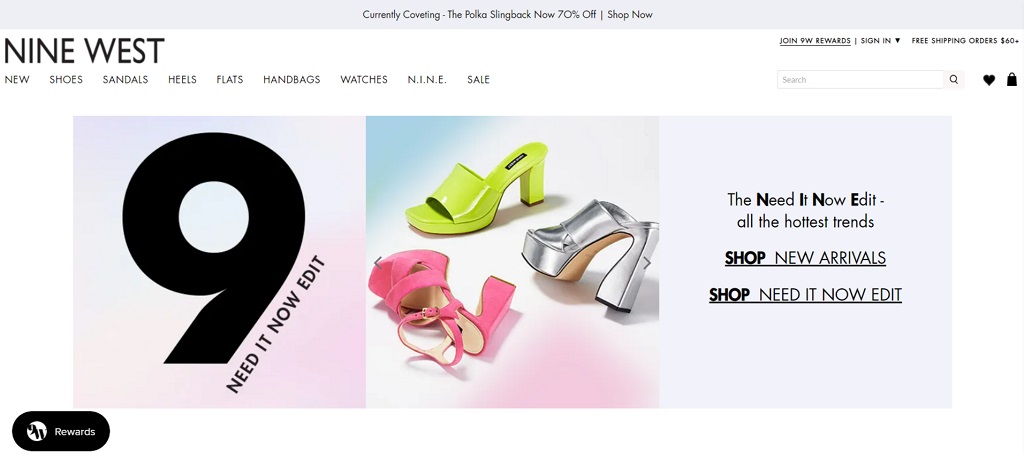
Nine West are a popular brand for stylish, extremely comfortable and affordable shoes. Its website design incorporates lots of negative or white space, which streamlines readability. Like Peltz Shoes it also allows customers to shop by size. We rate this part of its website design is slightly better than Peltz Shoes because the “Shop by size” banner is immediately visible on the homepage.
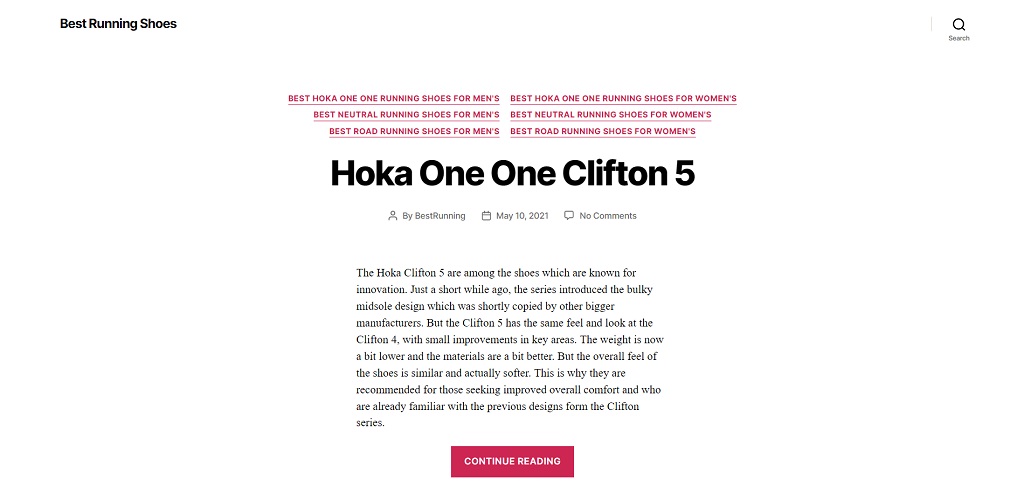
This unusual website design converts visitors into customers with its unique product descriptions. While lacking in visuals, its product descriptions offer honest reasons to buy and not buy particular shoe styles. Its minimal design with ample white space and a limited color palette is equally pleasant on the eyes.
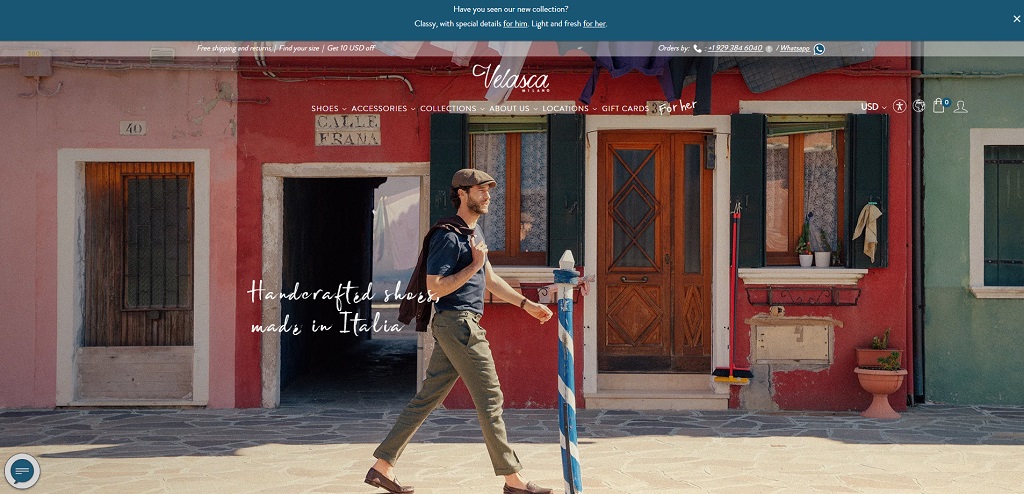
Velasca’s site embodies a typical Italian look-and-feel that’s classic and a bit old-school but still exudes gentlemanly style. Consequently, this brand transcends the ever-changing fast fashion trends, and instead, delivers craftsmanship steeped in tradition. It’s a drop-down menu and beautiful graphics invite users to linger a bit longer and experience a pleasurable buying journey.

ALDO designs shoes and accessories. It excels at fusing eCommerce with social media to amplify brand messaging and grow sales. As you scroll down the homepage, you’ll find a social media grid with the hashtag #aldocrew, which encourages consumers to shop trending looks and become of the brand’s community.
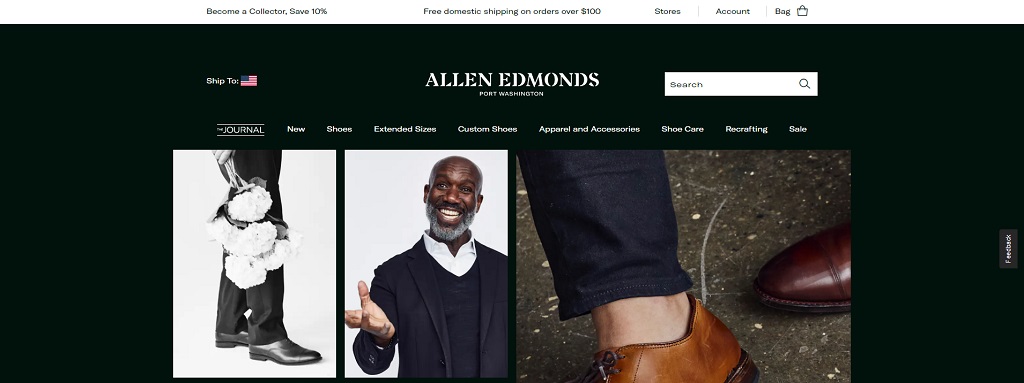
Allen Edmonds is a manufacturer of premium, timeless men’s footwear and accessories. The site provides a wealth of free resources for its visitors and guides prospective shoppers seamlessly and intuitively through the buying journey.
What’s most interesting is its blog section. Because it is a premium company, it’s renamed “the journal,” which is an important example of how messaging and brand identity play a role in website design.
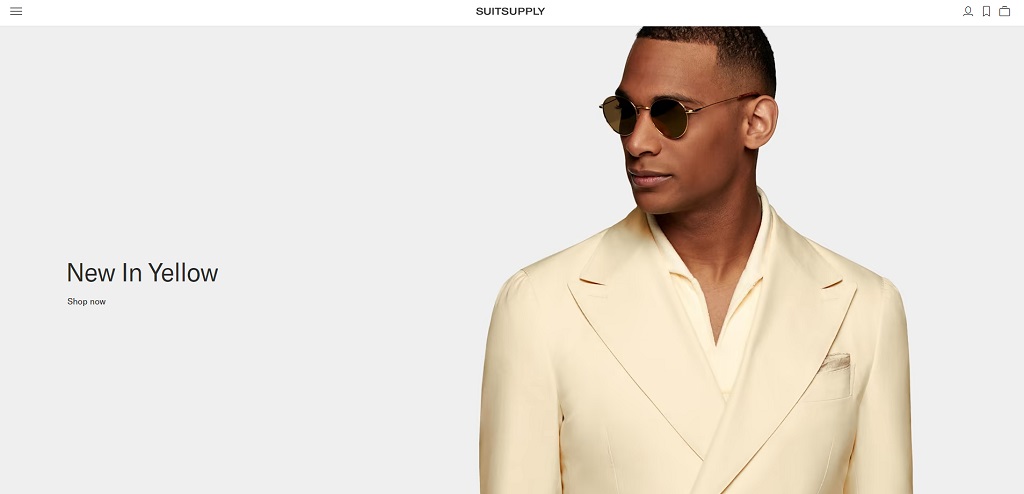
While not strictly a shoe retailer, Suitsupply illustrates the compelling power of strong visuals. Its website design is great for men who want an easy online shopping experience. Not only do its images encourage shoppers to buy things, but it also provides fashion inspiration. In general, the site is super simple to browse and locate what you’re looking for by clothing category.
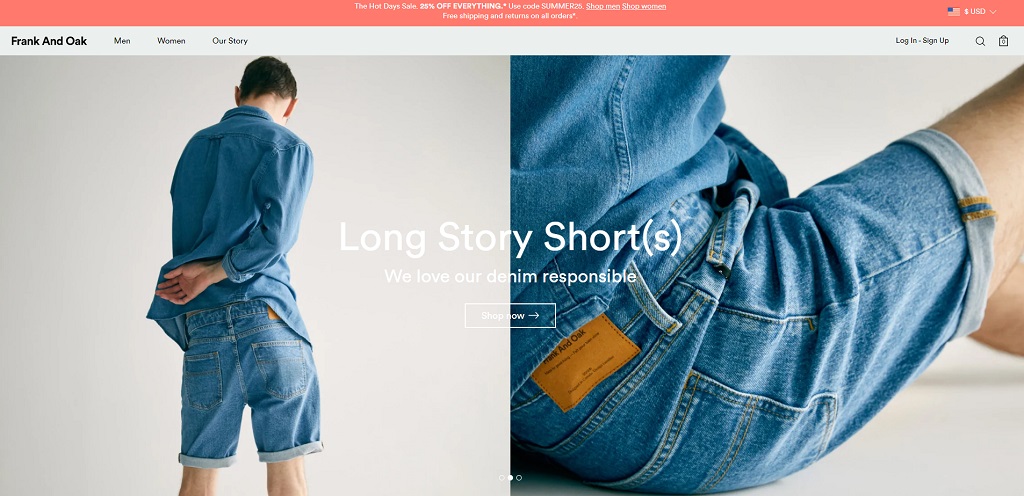
This eCommerce website is a prime example of how minimalist aesthetics can still draw potential shoppers through the “virtual” doors. Its “bestsellers” banner is a smart tactic to generate more sales and profit from existing traffic by focussing on the most popular products.
Moreover, it also inspires leads to open user accounts. This is another great marketing tactic used by eCommerce stores to gather customer data and personalize advertising content to move people further down the sales funnel.
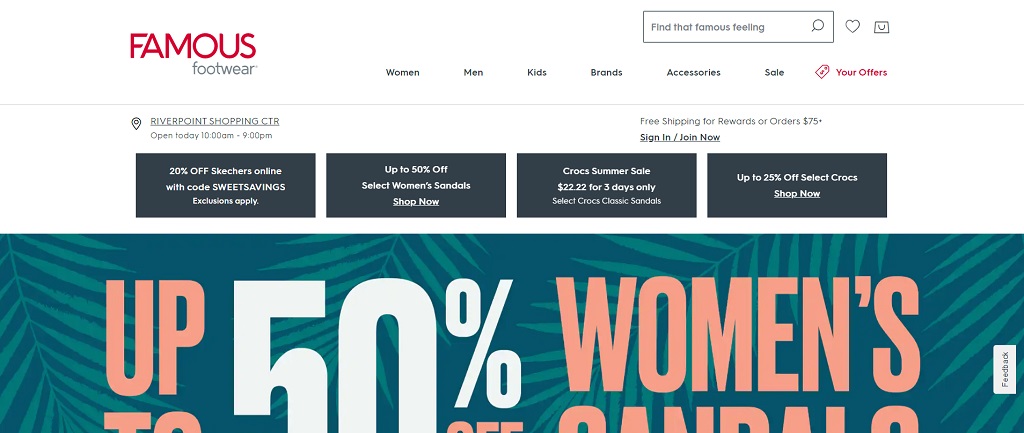
The assortment of shoes presented in a clean, non-cluttered manner helps visitors focus on items they truly need. Famous Footwear has also taken care to create a banner at the top of its website that pops up with renowned brands it stocks and provides another way for users to shop for their favorite brands.
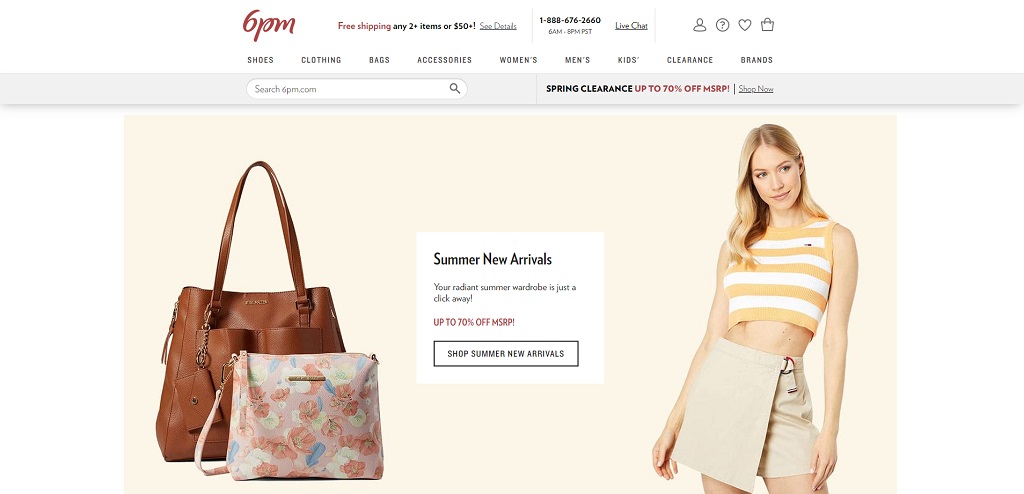
6PM offers shoppers the best deals on discounted fashion and shoes. Despite its massive product offering, its horizontal navigation bar categories products to ensure a smooth user experience. It features intuitive sort and filter options, while its detailed product descriptions ensure shoppers buy shoes with confidence.
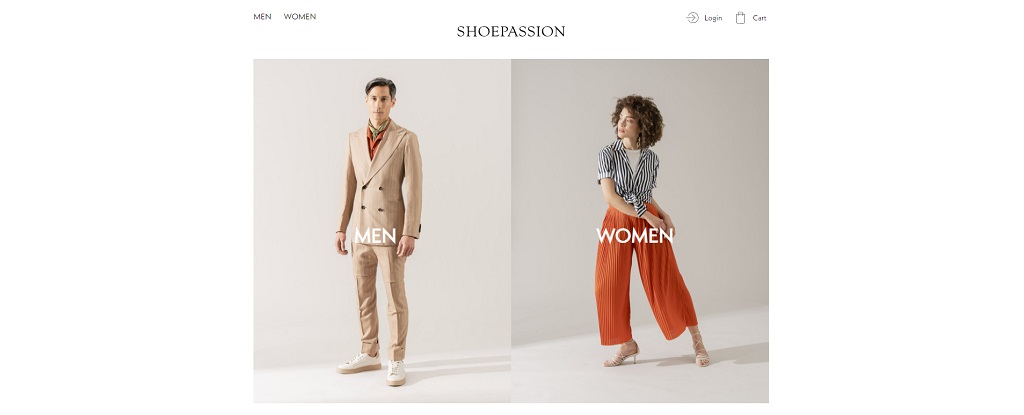
An informative drop-down menu and site feature that filters shoes by size and style adds to the user-friendly nature of this website design. ShoePassion’s blog is probably one of the best on this list. It discusses everything from shoe type to the manufacturing process. It makes visitors fall in love with the company while keeping them abreast of trends and classic shoe designs.
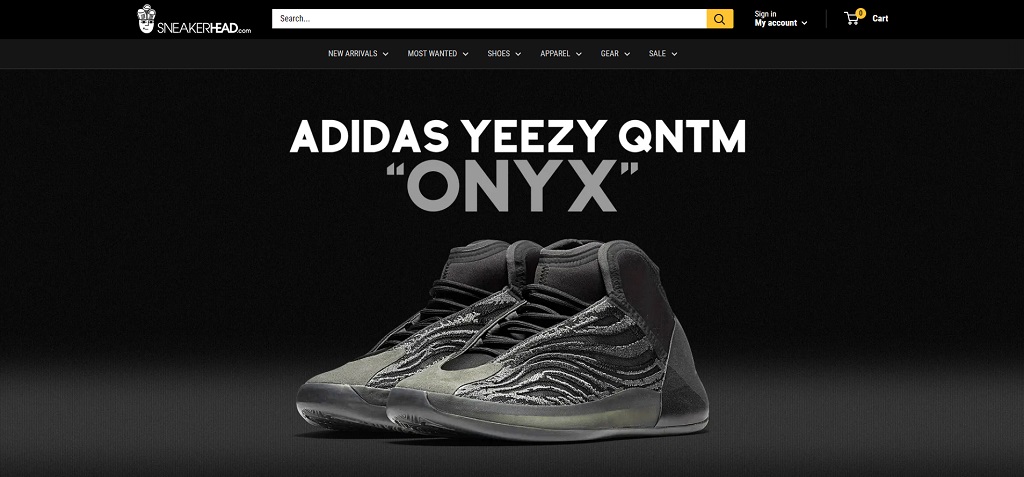
Sneakerhead’s vibrant website features great functionality that’s perfect for a youthful, web-savvy audience. The fun interface and engaging UX take shoppers through an effortless buying journey. Its “What’s hot” section immediately draws attention to the latest trends, while its intelligent drop-down sale menu categorizes products according to discount percentage.
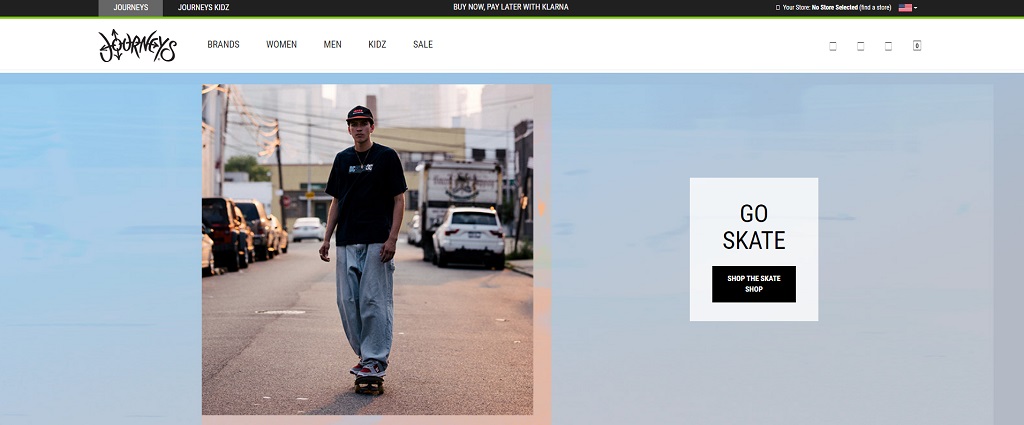
This modern, youthful shoe business features classic bestsellers and popular brands that appeal to a younger urban customer base. Its horizontal menu allows buyers to shop via gender or brand. Journeys also have unique calls to action on the home page, encouraging users to sign up for texts and emails or to be part of its birthday club. Obviously, this is a smart tactic to send marketing material to those who sign up.
International Ecommerce Shoe Websites
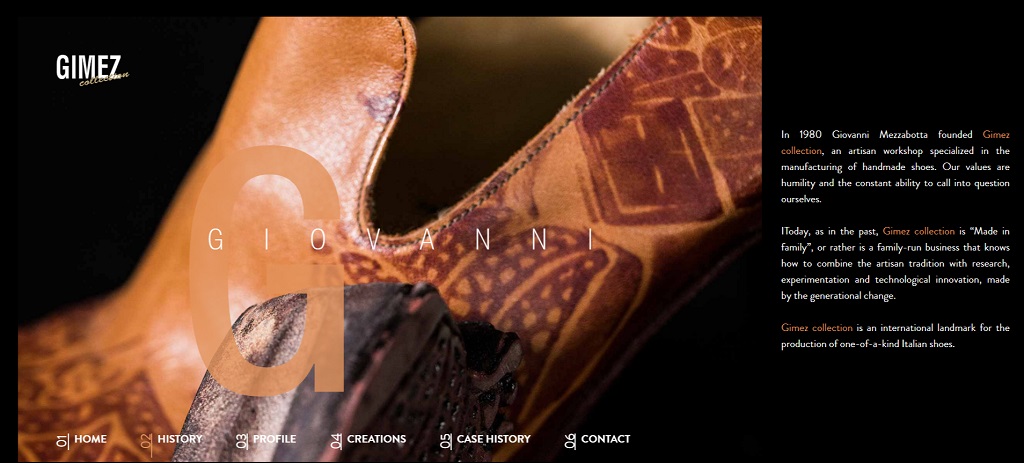
The high-quality product presentation is breathtaking, while the website design offers robust functionality that further reflects the brand’s commitment to superior custom shoes. Shoppers can easily focus on what they need and are taken through the buying journey in a comfortable thoughtful manner.
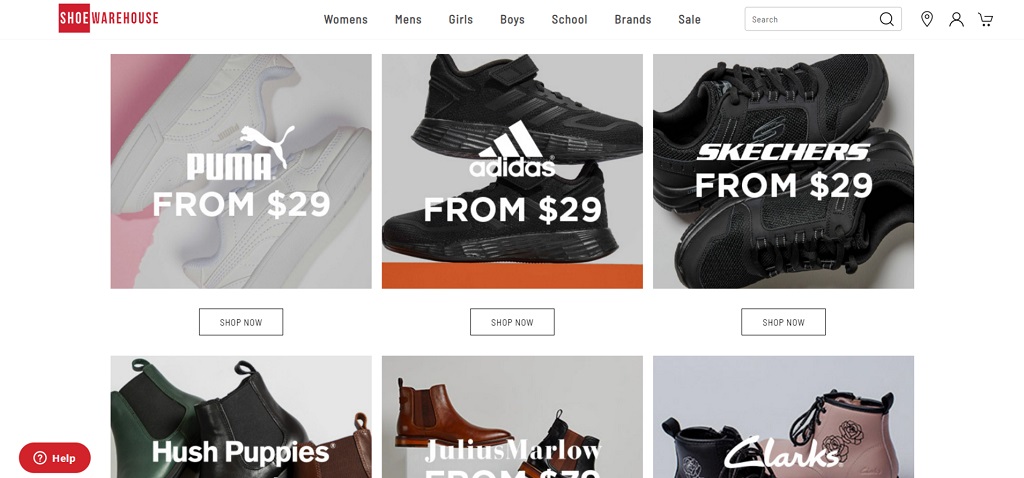
A simple yet efficient website design complete with detailed product information and an easy-to-navigate sorting option makes finding shoes for any member of the family a breeze. Like other shoes eCommerce stores, Shoe Warehouse immediately alerts shoppers to discount offers with its massive red banner. You literally cant miss it!
What Makes a Good Shoe Website Design?
The best eCommerce shoes website designs, and in fact, all the ones on our list, focus on content, usability, aesthetics, visibility, and interaction. Today’s sites are digital storefronts. They’re the first thing consumers interact with when they come across your eCommerce store.
A poor footwear eCommerce website design ruins customer experience. So, if you want a great website that shoppers recommend to friends and family, and select time and again, then read on.
UI & UX Design
Usertesting offers this succinct definition of UI and UX web design:
“UX design is focused on anything that affects the user’s journey to solve a problem, positive or negative, both on-screen and off. UI design is focused on how the website’s interface looks and functions.”
UX is to do with how users move around on your shoe website, whereas UI is about how nice your website looks. So, when you create or update your website idea, think about what impression it gives potential shoppers, and whether it matches your target audience’s expectations.
Both UX and UI help win over consumers’ confidence and make them use your website because it provides them with what they’re looking for. Happy shoppers buy more frequently, whereas dissatisfied cones will leave your website without having converted.
Mobile Device Optimization

It’s also essential your website is optimized for any mobile device. Why? Well, more than 50% of online searches are conducted via mobile. Google also ranks mobile-friendly website design higher. This is where hiring a professional designer to customize your website can really boost its functionality and search engine rankings.
Graphic Design
The websites we’ve highlighted have two design considerations in common: bold color palettes and strong graphics. The human mind is visually stimulated, so we tend to like to watch product videos and experience beautiful website design.
Designers often use visual hierarchy to create balance and harmony within website design. The idea is to rank design elements and influence in the order you want your users to view them. By using principles like balance, scale, contrast, and more, you establish each element in its right place and let the most important ones stand out.
For example, if you published an article where the header font was smaller than the body text, it would probably put off the viewers because according to design hierarchy, they’re accustomed to title appearing bigger than the actual article text.
Good shoe website design is uncomplicated. It uses light and dark colors (contrast) to draw attention to critical information, without overwhelming the viewer. Its great images and amazing layout makes it effortless to browse and buy.
Loading Speed
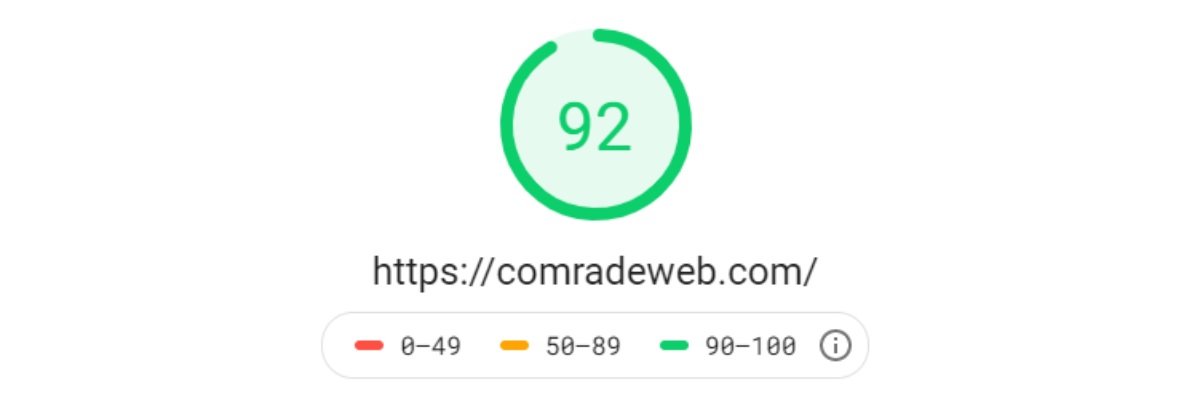
Google wants your website to load within two seconds! You probably noticed most of these online shoe stores loaded quickly, and that’s for a good reason. Web designers know loading time affects how high websites rank on Google.
Web pages that take three seconds or more lose potential leads. A one-second website page loading delay can cause a 7% reduction in conversions. Hence, fast commerce websites receive more organic traffic and sales because people equate speed with efficiency, confidence, and trust.
You can test website speed with Pingdom. If it’s too slow, try fixing it by deleting unnecessary code, decreasing pop-up advertisements, compressing images or upgrading your web host.
SEO shapes many choices during website development. Search engines love optimized eCommerce websites because they take quick to crawl and index, and are also immediately understandable.
Search Engine Optimization
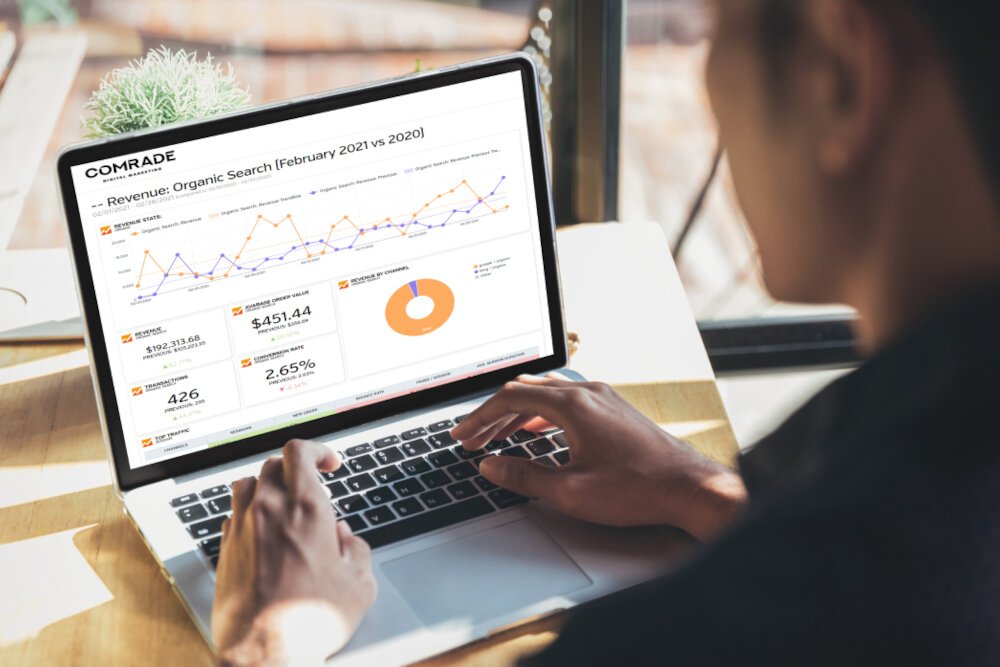
On-Page SEO
Having a strong on-page SEO strategy helps search engines understand what your shoe website is about. Including industry-related keywords in your website copy, meta titles, descriptions and body copy improves your website ranking in search engine results.
Additionally, like many of the website we’ve listed as inspiration, you should also publish high-quality content with amazing advice, as well as new styles and trends your target audience will love.
Technical SEO
Technical SEO makes your shoe website navigable without hindrances that could prevent it from ranking on search engines. Mobile-friendliness, website speed, URL structure and robot.txt files are all part of technical SEO.
Technical SEO is essentially all the invisible work that goes into making a functional website design. It’s likely you’ll need to hire technical SEO specialists to help with this complex aspect of website development.
Local SEO
97% of users search online to find nearby businesses; therefore, modern shoe businesses serving a particular region or location will benefit from local SEO. It helps your shoe website get found online by shoppers already searching for your products, whether it’s running sneakers or leather brogues etc. To implement local SEO, you need to sign up for a free Google My Business account and follow the guidelines.
Unique Selling Proposition

Every remarkable company has a unique proposition that makes it stand the test of time. For a shoe company this might reside in craftsmanship, limited designs, free repairs, or superior running sneakers – the possibilities are endless!
A unique selling proposition (USP) is what makes your shoe company better than your competition. You probably already know yours, but does your target audience?
When someone visits your commerce website, they should be able to tell what sets you apart from others, even if it’s just discounted shipping. Your written copy and web design must effectively communicate your USP.
Essentially, you need to tell shoppers why buying a pair of shoes from you is better than another commerce brand. Earlier we discussed the Italian shoemaker Velasca. Not only do they have a fantastic website, but they also clearly communicate how their workmanship sets them apart from others.

Important Shoe E-commerce Marketing Tips
How can I promote my shoe business?
- Leverage Word-of-Mouth Advertising – Encourage happy customers to recommend your business and products to their friends and family. This can be done through discounts for customer referrals or simply by asking them to spread the word about your offerings.
- Promote Your Products Using Social Media – Crafting creative content that promotes your products on social media is a great way to reach current and potential customers. Try creating visuals such as photos or videos, interactions with followers in comments and messages, and using advertising tools like boosting posts on Facebook or promoted tweets on Twitter .
- Set Up an Online Store – You can create a website for your business that includes product descriptions, buy-now buttons, and easy checkout processes for customers. Having an online store also allows you to reach new international customers who may not have been able to find you before!
- Create a Brand Ambassador Program – Consider partnering with influencers (who already have large followings) in order to gain more exposure for your shoes. You could offer free products or put coupons directly into their followers’ hands if they agree to post about your business.
- Hold Contests & Giveaways – Enticing potential customers by providing something of value (like free shoes) can drive traffic to both your physical store (if applicable) as well as any online channels like social media page or website you may operate. Plus, contests can help build buzz around your brand!
- Participate in Local Events & Trade Shows – Participating in local events is a great way to get people talking about your business, as long as you make sure you’re making connections with the right people at these events too! Paying for booth setup at a trade show also helps generate interest in what you have to offer without needing expensive advertising campaigns elsewhere?
- Utilize Email Marketing & Direct Mail – Remind former customers why they should come back by sending them emails showcasing new products or deals; considering traditional mailers (such as postcards or flyers) is another useful tactic when trying to target specific locations geographically near where one of your stores may be located
- Make Use Of SEO Tactics – SEO stands for search engine optimization which is all about making sure consumers are able to easily find information about what you offer when searching terms related to it on Google, Bing, etc… Many small businesses don’t leverage this type of technology so taking advantage of this low-cost opportunity could provide an edge over the competition!
- Develop Pay-Per-Click Advertising Campaigns – PPC campaigns involve bidding on certain keywords related directly to what you offer so that when someone types those words into Google (or any other search engine), they will see ads linked back directly towards pages associated with our business; while this form of digital marketing requires some up-front investment, it can be incredibly effective if properly managed!
- Host Online Events & Webinars – People love being involved in special events like webinars where they can connect with industry experts and learn more about what you do – especially if the event content is entertainingly presented! Consider hosting virtual “shoe shows” or Q&As where interested consumers can decide whether they want to purchase after learning more from those who know the best.
How do you attract people to buy shoes?
Shoes are an essential part of everyone’s wardrobe, so it’s important to make sure you’re able to attract people to buy the shoes you have for sale. Here are some tips for how to do just that:
- Offer attractive discounts and promotions – Use discounts and promotions to draw in potential customers who may already be interested in buying a pair of shoes. Try offering exclusive or limited-time discounts, free shipping, or store credits.
- Show off high-quality images – Photos say more than words ever will when selling products online. Make sure the photos of your shoes are clear, and bright, and showcase the unique features of each pair.
- Highlight customer reviews – Never underestimate the power of word-of-mouth advertising! If your shoes have been given positive reviews by customers, make sure those reviews are easy to find on your website.
- Create a comprehensive size guide – People’s feet come in all shapes and sizes, so provide helpful information on choosing the right shoe size every time. A comprehensive size guide can also help reduce returns as customers will know exactly what they’re expecting before they purchase their new shoes.
- Give customers multiple payment options – Customers want convenience when they purchase items online and offering them several payment options is a great way to provide it. The more methods you offer them, the more likely they’ll find one that meets their needs – including those who may not yet have access to credit cards like millennials or international buyers
These Custom Shoes Were Made for Walking
It takes more than great products to make your eCommerce store a success. Shoes should be presented in the most aspirational way. Your website should offer inspiration and quality products that consumers don’t just dream about, but can actually own.
In this case, professional website design becomes a powerful revenue driver. Comrade Digital Marketing Agency has a team with over ten years of experience in the eCommerce space, designing websites and digital marketing campaigns that turn impressive profits.
Our team would be happy to discuss your web design goals and how we can help you improve your bottom line. Why not let us conduct a web design audit free of charge? It’s non-obligatory, so regardless of the outcome, you’ll walk away armed with professional web design knowledge to elevate your eCommerce website to the next level.
Frequently Asked Questions
How do shoe companies attract customers?
Shoe companies have a few different strategies they can use to attract customers. Here are some of the top tips for attracting people to buy your shoes: 1. Make sure you have an attractive website – Your website should be aesthetically pleasing, easy to navigate, and offer plenty of product information. This will give potential customers the confidence they need to buy shoes from you. 2. Utilize social media – Social media is a great way to connect with potential customers and showcase your latest shoe designs or special offers. Engage with them by responding to their comments and messages, share fun content related to shoes, and keep them up-to-date on all the latest releases. 3. Use influencers – Find a few influencers that specialize in fashion or streetwear, and partner with them on promotional campaigns where they showcase your brand’s products. Influencers are often trusted more than brands themselves, so it's a great way for people to learn about your company's offerings in an engaging way. 4. Promote fan-favorite styles– Find out which styles of shoes are popular among your current customer base and focus marketing efforts around these favorites. Also consider creating limited edition items based off fan-favorites as this can be a great way to boost sales while offering something unique at the same time. 5. Offer discounts & promotions - Discounts and promotions can be useful when trying to drive new sales, so don’t hesitate to provide shoppers with incentives occasionally! Try offering exclusive discounts or discounts on specific items or collections that may help draw attention towards particular products you want them to purchase first or most often
How to advertise shoes for sale?
Create a catchy and original headline that encourages potential buyers to engage with your advertisement. Make sure the advertisement includes clear visuals of the shoes for sale, providing close-up details or multiple views of the product so that customers can see what they're buying. Highlight the value proposition of your product; why should customers buy this particular pair of shoes over others? Emphasize any benefits of the shoes such as comfort, longevity, quality, etc. Use customer reviews and testimonials to build trust with potential customers. Clearly state how much the product costs, including any additional taxes or delivery charges if applicable. Offer discounts or incentives to attract more customers (e.g., a 10% discount on purchases over $100). Choose a memorable brand name and slogan that will be associated with your advertisement and stay in people's minds for a long time after viewing it for the first time. Include contact information so those interested in making a purchase can easily get in touch with you or visit your website/social media page for further information about their transaction and delivery options etc.. Create an engaging call-to-action that gives potential customers one last nudge towards buying from you rather than elsewhere (for example: "Secure your spot now before it's too late!").
In what cities do you work?
Comrade originates in Chicago, but we worked all around the United States. We can help your business grow and increase revenue whenever you are. We have offices across most major cities in the US. For example, we can offer digital marketing services in Las Vegas or Orlando. You can even find our internet marketing experts in Jacksonville! If you want to know more about our Philadelphia digital marketing agency or find out how exactly we can help you, contact us via the phone or email.




